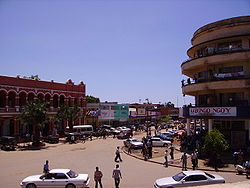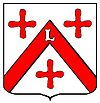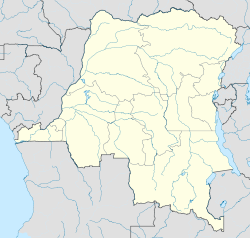
Lubumbashi
Background to the schools Wikipedia
SOS Children produced this website for schools as well as this video website about Africa. SOS Children works in 45 African countries; can you help a child in Africa?
| Ville de Lubumbashi | |||
|---|---|---|---|
|
|||
| Nickname(s): L'shi - Lubum | |||
| Province | Haut-Katanga Province | ||
| Government | |||
| • Governor | Moise Katumbi | ||
| Area | |||
| • Total | 747 km2 (288 sq mi) | ||
| • Land | 747 km2 (288 sq mi) | ||
| Elevation | 1,208 m (3,963 ft) | ||
| Population (2001) | |||
| • Total | 1,139,064 | ||
| • Density | 1,525/km2 (3,950/sq mi) | ||
| Time zone | DRC2 ( UTC+2) | ||
Lubumbashi (formerly French: Élisabethville, or Dutch: Elisabethstad) is the second largest city in the Democratic Republic of the Congo (formerly Zaire), second only to the nation's capital Kinshasa, and the hub of the southeastern part of the country. The copper-mining city serves as the capital of the relatively prosperous Haut-Katanga Province, lying near the Zambian border. Population estimates vary widely but average around 1.2 million.
Geography
Lubumbashi lies at around 1,000 metres above sea level. The Kafue River rises along the Zambian border near the city and meanders through parts of Zambia to the Zambezi River.
Government
From 2000-2006, Floribert Kaseba Makunko served as mayor of Lubumbashi; he was later elected to the National Assembly in 2006.
History
The Belgians founded the city of Élisabethville (sometimes Elizabethville, both in French, or Elisabethstad in Dutch) in 1910. The city prospered with the development of a regional copper mining industry.
Miners in Élisabethville conducted a strike in December 1941 to protest the increasingly severe forced-labor regime that the Belgians imposed on the population, because of the "war efforts".
The Belgians established the University of Élisabethville in 1954-1955 (now the University of Lubumbashi). In municipal elections in December 1957, the people of Élisabethville gave a vast majority to the Nationalist Alliance de Bakongo, which demanded immediate independence from the Belgians.
Élisabethville served as the capital and centre of the secessionist independent state of Katanga during the bloody 1960-1963 Congolese civil war. Moise Tshombe proclaimed Katangan independence in July 1960. Congolese leaders arrested him and charged him with treason in April 1961; however, he agreed to dismiss his foreign advisers and military forces in exchange for his release. Tshombe returned to Élisabethville but repudiated these assurances and began to fight anew. United Nations troops opposed Katangan forces and took control of the city in December 1961 under a strong mandate. Roger Trinquier, well known for his published works on counter-insurgency warfare, served as a French military advisor to President Tshombe until international pressure, led by Belgium, caused his recall to France.
Mobutu Sese Seko ultimately assumed power and renamed Élisabethville "Lubumbashi" and, in 1972 renamed Katanga "Shaba."
Congo entered another genocidal civil war in the 1990s. The Alliance of Democratic Forces for the Liberation of Congo rebels captured Lubumbashi in April 1997. Rebel leader Laurent-Désiré Kabila spoke from Lubumbashi to declare himself president of the Democratic Republic of the Congo on 17 May 1997 after Mobutu Sese Seko fled Kinshasa.
When Laurent-Désiré Kabila decided to appoint a transitional parliament, in 1999, a decision was made to install the Parliament in Lubumbashi, in order to consolidate the fragile unity of the country. The parliament was installed in the building of the National Assembly of secessionist Katanga, which had its capital in this city as well, in the 1960s. Lubumbashi was therefore the Legislative capital of the Democratic Republic of the Congo from 1999 to 2003, when all the country's central institutions were brought back to Kinshasa.
Culture and economy
Lubumbashi serves as an important commercial and national industrial centre. Manufactures include textiles, food products and beverages, printing, bricks, and copper smelting. The area also has a daily newspaper.
Transport
Rail
Lubumbashi lies at the centre of railway lines to Ilebo, Kindu, Sakania and Kolwezi, however, because of a lack of infrastructure investment in the rail system, the railway lines have a reputation for unreliability.
In the 1960s, the section from Mutshatsha to Lubumbashi was electrified at 25 kV AC.
Air
Lubumbashi is home to the modern Lubumbashi International Airport. The city consequently serves as a distribution centre for such minerals as copper, cobalt, zinc, tin, and coal.
Tourism
Attractions in the city include a botanical garden, a zoo, a brewery, and the regional archaeological and ethnological National Museum of Lubumbashi. The city also hosts the major University of Lubumbashi, which maintains a library.





